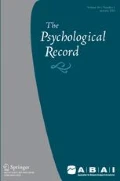Abstract
The behavior of dreaming has not received much attention from the behavioral community. Therefore, the purpose of the present paper is to provide a comprehensive behavior analytic interpretation of dreams. First, the paper briefly traces the development of dream theory from Greek philosophy, through empiricistic accounts, to the growing trend towards physiological explanations. Second, the paper discusses the existing behavioral interpretations of dreams based on the works of B. F. Skinner and of J. R. Kantor. Third, the paper suggests an alternative behavior analytic interpretation of dreaming based on the substitution of stimulus functions, and the performance of implicit actions lacking in order and effectiveness. Last, the paper provides suggestions as to the nature of dream research and to the understanding of dream meaning from a behavioral perspective.
Similar content being viewed by others
References
BENSON, C. (1970). Supernatural dreams and visions: Bible prophecy for the future revealed. Plainfield, NJ: Logos International.
BERGSON, H. (1958). The world of dreams. New York: Philosophical Library.
CARLSON, N. R. (1995). Physiology and behavior. Needham Heights, MA: Allyn and Bacon.
DEMENT, W. C. (1960). The effect of dream deprivation. Science, 131, 1705–1707.
DEMENT, W., & WOLFERT, E. A. (1958). The relation of eye movements, body motility, and external stimuli to dream content. Journal of Experimental Psychology, 55, 543–553.
DENNENT, D. C. (1976). Are dreams experience? Philosophical Review, 73, 151–171.
DENNENT, D. C. (1979). The onus re experiences. Philosophical Studies, 35, 315–318.
DESCARTES, R. (1962). Discounts on method. Chicago: Paquin Printers.
FREUD, S. (1994). The interpretation of dreams. New York: Random House. (Original work published in 1900).
HAYES, L. J. (1992). Equivalence as process. In S. C. Hayes & L. J. Hayes (Eds.), Understanding verbal relations. Reno, NV: Context Press.
HAYES, L. J. (1994). Substitution and reference. In L. J. Hayes & P. N. Chase (Eds.), Dialogues on verbal behavior. Reno, NV: Context Press.
HAYES, L. (1996) Substitution and reference. In L. J. Hayes & P. N. Chase (Eds.), Dialogues on verbal behavior. Reno, NV: Context Press.
HAYES, S. C. (1991). A relational control theory of stimulus equivalence. In L. J. Hayes & P. N. Chase (Eds.), Dialogues on verbal behavior. Reno, NV: Context Press.
HERGENHAHN, B. R. (1997). An introduction to the history of psychology. Pacific Grove, CA: Brooks/Cole.
HOBBES, T. (1962). Leviathan. New York: Macmillan. (Original work published in 1651).
HOBSON, J. A. (1992). A new model of brain-mind state: activation level, input source, and mode of processing (AIM). In J. S. Antrobus & M. Bertini (Eds.), The neurophychology of sleep and dreaming (pp. 227–246). New Jersey: Erlbaum.
JUNG, C. G. (1909). The analysis of dreams. New York: Harcourt Brace Jovanovich.
JUNG, C. G. (1928). Contributions to analytical psychology. New York: Harcourt Brace Jovanovich.
JUNG, C. G. (1934). Archetypes of the collective unconscious. New York: Harcourt Brace Jovanovich.
JUNG, C. G. (1965). Memories, dreams, reflections. New York: Vintage Books.
KANTOR, J. R. (1924). Principles of psychology (vol. 1). New York: Knopf.
KANTOR, J. R. (1926). Principles of psychology (vol. 2). New York: Knopf.
KANTOR, J. R., & SMITH, N. W. (1975). The science of psychology: An interbehavioral survey. Chicago, IL: Principia Press, Inc.
LAVIE, P., & HOBSON, J. A. (1986). Origin of dreams: Anticipation of modern theories in the philosophy and physiology of the eighteenth and nineteenth centuries. Psychological Bulletin, 100, 229–240.
LEIBNITZ, G. W. (1896). New essays concerning human understanding. London: Macmillan.
LEWIS, J. R. (1995). The dream encyclopedia. Detroit, MI: Visible Ink Press.
LUNAS, R. R., & PARE, D. (1991). Of dreaming and wakefulness. Neuroscience, 44, 521–535.
LOCKE, J. (1966). An essay concerning human understanding. Dent: London. (Original work published 1690).
MALCOLM, N. (1956). Dreaming and skepticism. Philosophical Review, 65, 14–37.
MALCOLM, N. (1959). Dreaming. London: Routledge & Kegan Paul.
PARROTT, L. J. (1986). On the role of postulation in the analysis of inapparent events. In H. W. Reese & L. J. Parrott (Eds.), Behavior science: Philosophical, methodological and empirical advances. Hillsdale, NJ: Erlbaum.
SIDMAN, M. (1994). Equivalence relations and behavior: A research story. Boston, MA: Authors Cooperative, Inc.
SKINNER, B. F. (1938). The behavior of organisms. New York: Appleton Century Crofts.
SKINNER, B. F. (1953). Science and human behavior. Toronto, Ontario: Macmillan.
SKINNER, B. F. (1957). Verbal behavior. New York: Appleton Century Crofts.
SKINNER, B. F. (1969). Contingencies of reinforcement: A theoretical analysis. New York: Appleton Century Crofts.
SKINNER, B. F. (1972). About behaviorism. New York: Knopf.
VON GRUNEBAUM, G. E., & CAILLOIS, R. (1966). The dream and human societies. Berkeley, CA: University of California Press.
Author information
Authors and Affiliations
Additional information
This paper was written in partial fulfillment of Mark R. Dixon’s doctoral degree at the University of Nevada.
Rights and permissions
About this article
Cite this article
Dixon, M.R., Hayes, L.J. A Behavioral Analysis of Dreaming. Psychol Rec 49, 613–627 (1999). https://doi.org/10.1007/BF03395331
Published:
Issue Date:
DOI: https://doi.org/10.1007/BF03395331



